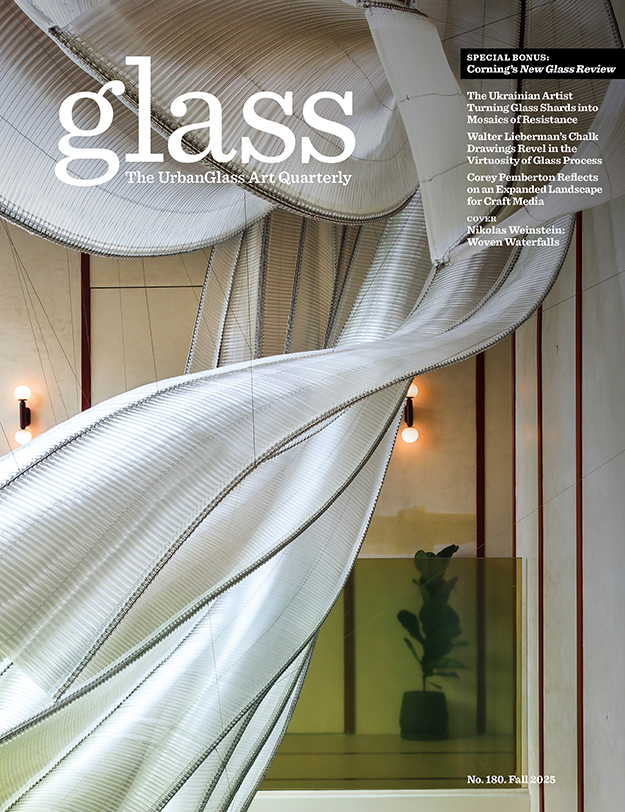Issue 180 | Fall
Editor's Letter
by Andrew Page
There’s a disorientation that flows from great transition, and we’re living through more than one. Whether it’s AI or the political moment, there’s a very real sense of the systems and norms in place for generations being undone, all at once, and without precedent. Despite the very real uncertainty about where we are headed, there is, when you look closer, connections between people and things that may be harder to see, but which underpin our relationships and the world around us (and can provide solace in chaotic moments). Societies, like organisms, are made up seemingly infinite small relationships that are far less visible—or changeable—than the world of politics or technology.
This issue explores some of that same connective tissue, the things that not only link us together, but that literally form the very structure of our selves as living organisms. Nikolas Weinstein’s epic structures, made of woven curtains of borosilicate rods, are inspired by the repetition and interlacing of tiny components that go from nearly microscopic in size to monumental forms in organisms from the plant and animal worlds.
In a wide-ranging interview with Glass, Weinstein celebrates the power of natural systems that multiply the strength and scale of individual components when knitted together, which is the way a single thin tube of boro can become part of an eight-story-tall cascade of light and translucence that takes your breath away, as we see in the image on this cover of “Mangrove,” an installation in the lobby of a hotel in Asia.
Walter Lieberman takes something as small as a piece of chalk, and uses it to sketch flowing line drawings that turn a handful of people working together at a bench into a symphony of creative precision and collaboration. Jabari Owens-Bailey noticed how Lieberman’s deep knowledge as a glassblower comes together with exquisite draftsmanship in these remarkable diagrams that unlock process so that Museum of Glass general audiences can appreciate the virtuosity on display.
Corey Pemberton, cofounder of Crafting the Future, creates small opportunities—an internship, a scholarship to attend a workshop, a gathering of glassblowers of color—and through them builds real change in the field of glass and other craft materials. Ellye Sevier checks in with Pemberton’s project five years in and notes how major transformation can be achieved through an amalgamation of micro-steps.
And finally, we look at the power that flows from the simple act of picking up the shards of glass from Russian bombardment of a Ukrainian city and reassembling them into mosaics that speak of resilience and determination. Kharkiv-based artist Valentina Guk’s response to the destruction of her balcony windows took her no time to ponder—she instinctively gathered up the shattered glass and set to work to reassemble them into timeless images of hope for a future that reflects the unshakeable will of a people to live free.
Hourglass
After a successful annual fundraiser, GlassRoots looks ahead to a long-awaited move into an expanded facility; an African network of glass artists hosts its first exhibition, seeking to build bridges between artists and organizations across the continent; in memoriam: Brian Clarke (1953–2025); UrbanGlass welcomes Haley Andres as director of development.
Reviews
Sharmistha Ray and Dannielle Tegender at Grand Central Station, New York; Marcantonio Brandolini d’Adda at David Gill Gallery, London; David Schnuckel at the Museum of American Glass, WheatonArts, Millville, New Jersey; Christen Baker and Victoria Ahmadizadeh Melendez at Grizzly Grizzly, Philadelphia. llville, New Jersey; Christen Baker and Victoria Ahmadizadeh Melendez at Grizzly Grizzly, Philadelphia.
UrbanGlass News
Please Eat the Art! Fall Fundraiser Invites the Community to Gather and Feast
UrbanGlass Catalogue
Christina Bothwell, “Screen Memories,” curated by Doug Heller, at the Robert Lehman Gallery, and Heidi Mortensen, “Holding Memories,” juried by Abram Deslauriers, Benjamin Sutton, and Mollie McKinley, at the Window Gallery.
Reflection
by William Warmus
Happy 100th Birthday, Studio Glass?
Features
Tapestries of Light
by Andrew Page
An obsessive problem-solver, Nikolas Weinstein figured out how to shape and network borosilicate tubing to build at unprecedented scale in glass. With organic structures as inspiration, he’s created ever more massive and complex installations, such as an eight-story-tall billowing glass “tree” certified as the largest such installation in the world.
Unbroken
by Oscar Bembury
Out of a shattered landscape, Ukrainian artist Valentina Guk creates glass mosaics embodying the resilience of her culture and Kharkiv’s determination to live free.
Swept Away
by Jabari Owens-Bailey
Walter Lieberman’s chalk drawings on the floor of the Museum of Glass hot shop reveal the extraordinary knowledge of their author. A museum exhibition elevates and preserves these elegant and informative diagrams so their embedded expertise and skill outlast the day’s hot-shop cleanup.
Change Agents
by Ellye Sevier
The political landscape has changed radically since 2019, when Crafting the Future launched, but cofounder Corey Pemberton says that the organization dedicated to nurturing the expanding number of Black and Brown craft artists is going strong.



